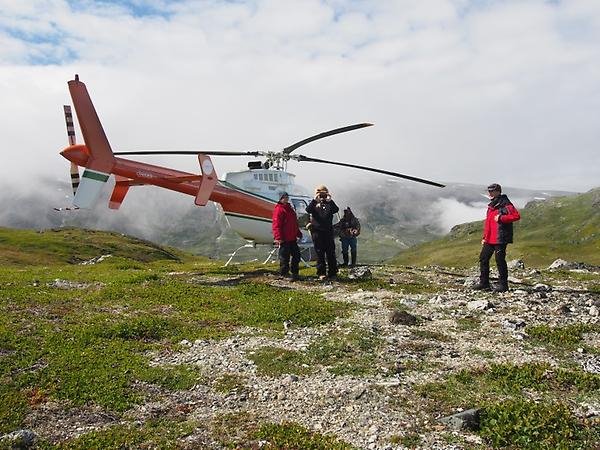Evolution of the North Atlantic Craton

Fieldwork in the Saglek Block, Labrador, 2014.
Summary
The North Atlantic Craton, stretching from northern Canada through Greenland, Scotland and into northern Fennoscandia, contains some of the best exposures of Earth’s earliest continental crust
(ca. 3.9 Ga), as well as preserving a record of crust generation processes in the Neoarchean, a time when modern plate tectonic processes were becoming fully developed. The work of the project is divided into three main areas:
1) Northern Labrador (Saglek region). While this area has been long-known to contain early Archean gneisses correlative with southern West Greenland, it has remain poorly investigated due to the complex logistics involved as well as the generally higher grade of metamorphism that obscures its earliest evolution. Our field sampling in 2014 and subsequent isotopic work is revealing a more complex set of early-Archean magmatic events than previously known and forms the basis for ongoing field investigations and future work.
2) Southern West Greenland (Nuuk region). Despite a vast amount of field and laboratory work by various groups over four decades, the evolution of the Nuuk region, the largest area of exposed early Archean crust on Earth, still remains controversial, not least with regard to its potential to host early terrestrial biology. Our work comprises studies of gneisses using zircon geochronology and Hf isotopes to reconcile conflicting views of mantle-crust differentiation at this time as well as addressing the protoliths of putative life-hosting lithologies.
3) Northern Scotland (Lewisian Complex). This is an exceptionally well-studied natural laboratory for investigating Neoarchean crust formation mechanisms using new isotopic approaches, specifically linking geochronology and Hf isotopes to determine the extent to which depleted mantle versus more enriched protocrust has contributed to crustal growth at this time.
This work is partly funded by the Knut and Alice Wallenberg Foundation and the Swedish Research Council (VR) and was previously funded by the European Union (Marie Curie Actions).
Project participants at the museum
- Martin Whitehouse (principle investigator)
External project participants
- Christopher Fedo (researcher), University of Tennessee, USA.
- Monika Kusiak (researcher), Polish Academy of Sciences, Poland
- Anna Salicinska (Ph.D. student), Polish Academy of Sciences, Poland
- Anthony Kemp (researcher), University of Western Australia, Australia
- Dan Dunkley (researcher), Curtin University, Australia
Selected publications
- Whitehouse, M.J., Schoenberg, R., Fedo, C.M., Kamber, B.S. (2015). Does a Heavy Fe-Isotope Composition of Akilia Quartz-Amphibole-Pyroxene Rocks Necessitate a BIF Origin? Astrobiology 15, 816-824.
- Whitehouse, M.J. & Kemp, A.I.S. (2010). On the difficulty of assigning crustal residence, magmatic protolith and metamorphic and ages to Lewisian granulites – constraints from combined in situ U-Pb and Lu-Hf. In: Law, R.D., Butler, R.W.H., Holdsworth, R., Krabbendam, M. and Strachan R. (editors). Continental Tectonics and Mountain Building: The Legacy of Peach and Horne. Geological Society of London Special Publications 335, 81-101 (dx.doi.org/ 10.1144/SP335.5
 ).
). - Whitehouse, M.J., Myers, J.S. & Fedo, C.M. (2009). The Akilia Controversy: field, structural and geochronological evidence questions interpretations of > 3.8 Ga life in SW Greenland. Journal of the Geological Society 166, 333-344.
- Whitehouse, M.J. & Fedo, C.M. (2007). Searching for Earth’s earliest life in southern West Greenland – history, current status, and future prospects. In: M.J. Van Kranendonk, R.H. Smithies and V. and Bennett, V., Earth’s Oldest Rocks. Developments in Precambrian Geology: Elsevier 15, 841-853.
More information
Youtube Video: Zircons—Time Capsules from the Early Earth


